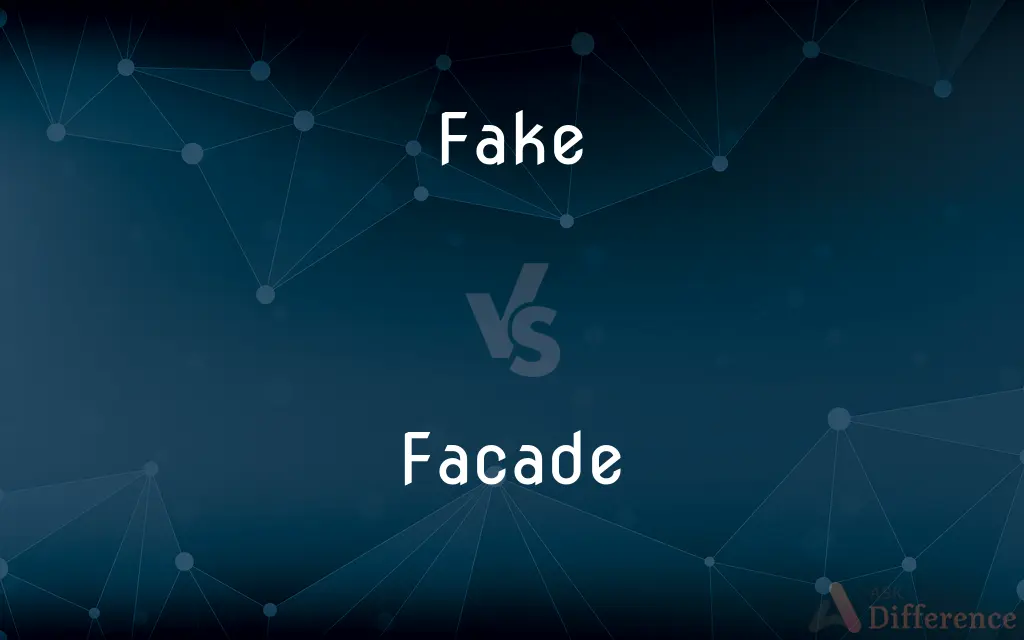Fake vs. Facade — What's the Difference?
By Urooj Arif & Fiza Rafique — Updated on March 12, 2024
Fake refers to anything not genuine or counterfeit, while facade is a superficial appearance or illusion maintained to conceal a less pleasant reality.

Difference Between Fake and Facade
Table of Contents
ADVERTISEMENT
Key Differences
Fake encompasses a wide range of objects, behaviors, and even emotions that are not authentic. It implies imitation or duplication, often with the intent to deceive. Fakes are designed to appear as genuine as possible, whether it’s counterfeit goods, forged documents, or insincere actions. On the other hand, a facade is specifically an outward appearance maintained to hide one's true feelings, intentions, or the state of things. It’s about putting up a front or a veneer, typically to project a more favorable image than what lies beneath.
While fake objects or actions are created with the intent to deceive by passing off as the original, a facade doesn't necessarily involve tangible items. Instead, it's more about creating a misleading impression through one’s demeanor or the strategic presentation of information. For example, a person might maintain a cheerful facade to hide their sadness, or a company might use marketing tactics to create a facade of success despite financial struggles.
Fakeness can be applied to tangible and intangible items alike, encompassing everything from counterfeit products to fake friendships. It questions the authenticity of the item or relationship itself. In contrast, a facade refers to an intentional effort to mask or distract from an underlying truth, focusing on the discrepancy between appearance and reality. It’s about the contrast between what is shown and what is concealed.
The concept of being fake often carries a negative connotation, suggesting deceit, inferior quality, or lack of sincerity. Similarly, maintaining a facade is generally viewed unfavorably, as it implies a lack of transparency and possibly manipulation. Both concepts deal with the idea of deception but differ in their application and implications. While fakeness directly challenges the authenticity of something, a facade pertains to the effort to cover up or disguise the truth.
In the context of social interactions, fakeness might refer to inauthentic behavior or emotions, whereas a facade could be seen as the specific act of pretending or acting in a certain way to conform to societal expectations or personal goals. Both strategies might be used to navigate social dynamics, but a facade often involves a more conscious effort to manage perceptions.
ADVERTISEMENT
Comparison Chart
Definition
Not genuine or counterfeit.
Superficial appearance to conceal reality.
Application
Objects, documents, emotions.
Appearance, demeanor, information presentation.
Intent
To deceive by imitation.
To mask or distract from the truth.
Scope
Tangible and intangible items.
Primarily intangible, related to impressions.
Connotation
Negative, suggests deceit.
Negative, implies lack of transparency.
Compare with Definitions
Fake
Counterfeit or not genuine.
The museum discovered the painting was a fake.
Facade
Superficial or deceptive outward appearance.
Despite the smiles, her happiness was just a facade.
Fake
Fabricated story or fact.
The rumors turned out to be completely fake.
Facade
Architectural front of a building.
The building's facade was restored to its original beauty.
Fake
Imitation product.
The market was flooded with fake designer bags.
Facade
Strategy to mask true feelings or situations.
He maintained a facade of indifference, but he was deeply hurt.
Fake
Insincere or pretentious behavior.
Their apology felt fake and unconvincing.
Facade
Illusion created to project a certain image.
The company's successful facade hid its financial troubles.
Fake
Artificial or simulated.
The movie used fake blood for special effects.
Facade
Pretense or show put on to conceal something.
Their marriage was a facade to appease their families.
Fake
Not genuine; imitation or counterfeit
She got on the plane with a fake passport
A fake Cockney accent
Facade
The face of a building, especially the principal face.
Fake
A thing that is not genuine; a forgery or sham
Fakes of Old Masters
Facade
An artificial or deceptive front
Ideological slogans that were a façade for power struggles.
Fake
Variant spelling of flake
Facade
(architecture) The face of a building, especially the front view or elevation.
Fake
Forge or counterfeit (something)
She faked her spouse's signature
Facade
(by extension) The face or front (most visible side) of any other thing, such as an organ.
Fake
Variant spelling of flake
Facade
(figuratively) A deceptive or insincere outward appearance.
Fake
Having a false or misleading appearance; fraudulent.
Facade
(programming) An object serving as a simplified interface to a larger body of code, as in the facade pattern.
Fake
One that is not authentic or genuine; a sham.
Facade
The front of a building; esp., the principal front, having some architectural pretensions. Thus a church is said to have its façade unfinished, though the interior may be in use.
Fake
(Sports) A brief feint or aborted change of direction intended to mislead one's opponent or the opposing team.
Facade
The face or front of a building
Fake
One loop or winding of a coiled rope or cable.
Facade
A showy misrepresentation intended to conceal something unpleasant
Fake
To contrive and present as genuine; counterfeit
Fake a signature.
Fake
(Music) To improvise (a passage).
Fake
(Sports) To deceive (an opponent) with a fake. Often used with out.
Fake
To engage in feigning, simulation, or other deceptive activity.
Fake
(Sports) To perform a fake.
Fake
To coil (a rope or cable).
Fake
Not real; false, fraudulent
Which fur coat looks fake?
Fake
(of people) Insincere
Fake
Something which is not genuine, or is presented fraudulently.
I suspect this passport is a fake.
Fake
(sports) A move meant to deceive an opposing player, used for gaining advantage for example when dribbling an opponent.
Fake
(archaic) A trick; a swindle
Fake
(nautical) One of the circles or windings of a cable or hawser, as it lies in a coil; a single turn or coil.
Fake
(transitive) To make a counterfeit, to counterfeit, to forge, to falsify.
Fake
(transitive) To make a false display of, to affect, to feign, to simulate.
To fake a marriage
To fake happiness
To fake a smile
Fake
(archaic) To cheat; to swindle; to steal; to rob.
Fake
(archaic) To modify fraudulently, so as to make an object appear better or other than it really is
Fake
To improvise, in jazz.
Fake
(nautical) To coil (a rope, line, or hawser), by winding alternately in opposite directions, in layers usually of zigzag or figure of eight form, to prevent twisting when running out.
Fake
One of the circles or windings of a cable or hawser, as it lies in a coil; a single turn or coil.
Fake
A trick; a swindle.
Fake
To coil (a rope, line, or hawser), by winding alternately in opposite directions, in layers usually of zigzag or figure of eight form,, to prevent twisting when running out.
Fake
To cheat; to swindle; to steal; to rob.
Fake
To make; to construct; to do.
Fake
To manipulate fraudulently, so as to make an object appear better or other than it really is; as, to fake a bulldog, by burning his upper lip and thus artificially shortening it.
Fake
Something that is a counterfeit; not what it seems to be
Fake
A person who makes deceitful pretenses
Fake
(football) a deceptive move made by a football player
Fake
Make a copy of with the intent to deceive;
He faked the signature
They counterfeited dollar bills
She forged a Green Card
Fake
Fake or falsify;
Fudge the figures
Cook the books
Falsify the data
Fake
Talk through one's hat;
The politician was not well prepared for the debate and faked it
Fake
Fraudulent; having a misleading appearance
Fake
Not genuine or real; being an imitation of the genuine article;
It isn't fake anything; it's real synthetic fur
Faux pearls
False teeth
Decorated with imitation palm leaves
A purse of simulated alligator hide
Common Curiosities
What is a facade in social terms?
A superficial appearance maintained to hide one’s true feelings or the reality of a situation.
Can a facade involve fake elements?
Yes, a facade can involve fake elements as part of maintaining the appearance or illusion.
Why do people create facades?
To manage perceptions, conform to expectations, or hide undesirable truths.
How do fake and facade differ in application?
Fake can apply to tangible and intangible items aiming to deceive, while facade is about maintaining an appearance to conceal something.
Is it always negative to use a facade?
Not necessarily, as facades can sometimes be used for protective purposes or social diplomacy.
Why might a business maintain a facade?
To protect its reputation, attract investment, or maintain customer confidence during challenging times.
What defines something as fake?
Something not genuine, often created to deceive by imitation.
How can one identify something as fake?
Through discrepancies between its appearance and the characteristics of the genuine article, or inconsistencies in behavior.
What role does intention play in differentiating fake from facade?
Intention is central; fake involves direct imitation to deceive, while a facade is about creating a misleading impression, often with more complex motivations.
How does the concept of being fake affect personal relationships?
It can erode trust, create misunderstandings, and damage the relationship’s foundation.
What is the difference between a fake smile and a facade of happiness?
A fake smile is a single insincere gesture, while a facade of happiness involves a broader effort to appear happy consistently.
What impact do fakes have on society?
They can undermine trust, affect economic and personal relationships, and lead to legal issues.
How do cultural perceptions of fake and facade vary?
Cultural values around authenticity, honesty, and appearance can influence how negatively or pragmatically these concepts are viewed.
Can a facade be positive?
In some contexts, maintaining a positive facade can help preserve social harmony or provide personal security.
Can facades be sustainable long-term?
Maintaining a facade long-term can be psychologically taxing and potentially lead to breakdowns in authenticity.
Share Your Discovery

Previous Comparison
Mono vs. Logo
Next Comparison
Subgenre vs. GenreAuthor Spotlight
Written by
Urooj ArifUrooj is a skilled content writer at Ask Difference, known for her exceptional ability to simplify complex topics into engaging and informative content. With a passion for research and a flair for clear, concise writing, she consistently delivers articles that resonate with our diverse audience.
Co-written by
Fiza RafiqueFiza Rafique is a skilled content writer at AskDifference.com, where she meticulously refines and enhances written pieces. Drawing from her vast editorial expertise, Fiza ensures clarity, accuracy, and precision in every article. Passionate about language, she continually seeks to elevate the quality of content for readers worldwide.
















































